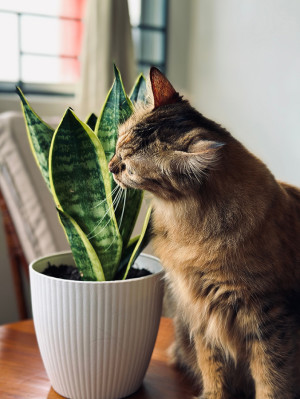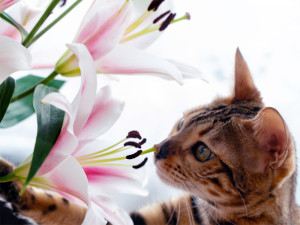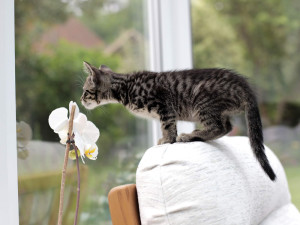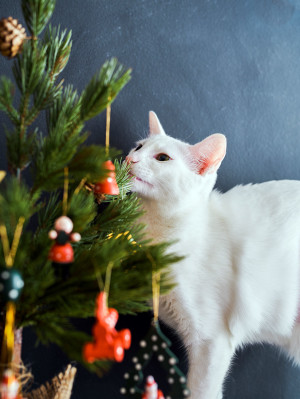What Flowers Are Toxic to Cats?
Find out what you can and can’t plant in your garden.
If you’re a plant parent and a cat parent, you may worry about your babies coexisting. Cats can be highly destructive to plants (and most things in your home), but some flowers also pose a threat to your cat. Many flowers contain toxins that can cause mild to severe symptoms in cats if consumed — and some can even be downright deadly. It’s important for pet parents to know exactly which plants are safe to have around their cats and which need to stay far away.
One of the most dangerous flowers are those in the lily family, which can cause acute, potentially fatal kidney failure in felines, even if they just lick pollen from the flowers. Be sure to keep these plants away from your cat, as well as those that contain dangerous toxins, including:
Daffodil, which contains the poisonous agent lycorine
Autumn crocus
Azalea
Rhododendron
Hyacinth
Oleander
Why are some flowers dangerous for cats?
Some plants are highly toxic to cats, while others don’t present any threat at all. Many plants cause mild side effects, like gastrointestinal symptoms (vomiting or diarrhea) or irritation to the mouth and tongue. However, other plants contain toxins that are life-threatening, causing heart problems, difficulty breathing, seizures, or damage to organs like the liver and kidneys.
“There are numerous plants and flowers that are potentially toxic to cats,” Dr. Amy Fox says. “Lilies are one of the most infamous flowers that are toxic to cats, as they can cause potentially fatal kidney failure if consumed.”
How much do you spend on your pet per year?
What should I do if my cat has eaten a toxic flower?
If you suspect your cat has consumed a toxic flower, contact your vet immediately or visit an emergency vet clinic. You can also call an animal poison control helpline, like the ASPCA Poison Control Centeropens in new tab at 888-426-4435 or the Pet Poison Helplineopens in new tab at 855-764-7661.
When you head to the vet, make sure to bring along samples or photos of the plant if possible and be prepared to provide information about the type of plant, how much your cat ingested, and how long it’s been since they ate the flower.
Diagnosing plant poisoning in cats
The more information you can provide to your vet about the plant your cat consumed, the quicker they can reach a diagnosis and start treatment. If you aren’t able to provide any details, the vet will have to run a series of tests to determine what type of poison your cat was exposed to and develop a treatment plan.
Symptoms of plant poisoning in cats
If you have toxic plants in the home, be aware of the symptoms of plant poisoning. Contact your vet immediately if you notice your cat has any of these symptoms:
Vomiting or diarrhea
Abdominal pain
Drooling
Lethargy
Loss of appetite
Mouth or tongue irritation
Difficulty swallowing
Tremors or seizures
Treatment
The treatment your vet decides on will depend on how serious the case of poisoning is for your cat. Your vet may suggest hospitalization for more serious cases, while more mild cases may involve treating your cat for nausea or diarrhea.
How to prevent plant poisoning
To keep your cat from ingesting a toxic flower, find ways to keep potentially poisonous plants out of their reach. Try elevating plants, whether in hanging planters or in large containers or planters that can keep your cat from accessing the flower itself. Take the time to learn about which plants are toxic to your cat so you can more easily identify — and avoid — them.
“Pet parents should always do their research about a specific plant they are considering bringing into their home to learn about risks of toxicity to their pets,” Dr. Fox says. “The ASPCA poisonous plant database onlineopens in new tab is a great resource to learn about thousands of plants and their safety and toxicity profiles.”
If you do have unsafe plants in your home, think about the best place to put them to keep your cat away. Remember that cats are able to jump and climb, so simply setting a plant on a shelf often won’t be good enough.
Are all parts of a toxic flower poisonous to cats?
Some plants are poisonous to cats regardless of which part they eat, while others may contain toxins only in specific parts, like the bulbs, leaves, or flowers. Make sure to know which plants present a danger to your cat and which are safe to have around the house or garden.
How do I stop my cat from eating toxic flowers?
The best way to keep your cat from eating poisonous flowers is to keep them out of your home entirely. At the very least, keep toxic plants out of your pet’s reach by using hanging planters or keeping them in a room with a door you can close. If your cat goes outside, make sure they do so supervised, preferably on a leash or harness, or make use of a catio. Be sure to research any plant you want to add to your home or garden to determine if it’s safe for your cat to be around.
Flowers that are safe for cats
If you want to brighten up your home with flowers but still keep your cat safe, look for these plants that are safe to have around cats:
Bamboo
Money tree
Mosaic plant
Friendship plant
Ponytail palm
Flowers that are dangerous for cats
Many flowers are potentially toxic to cats, whether just a particular part of the plant, like the leaves or stem, or the entire flower. Make sure to keep these flowers away from your cat:
Aloe
Ivy
Foxglove
Bird of Paradise
Peony
Periwinkle
American Holly
Amaryllis
Gardenia
Azalea
Bottom line: Are all plants poisonous for my cat?
Not all plants are dangerous to your cat. In fact, many plants are non-toxic and perfectly safe to have around your feline friend. As a cat parent, it’s important to do your research and learn which flowers are safe for your cat before bringing any plant into your home or garden.
FAQs (People also ask):
What happens if my cat eats a toxic flower?
It depends on the type of flower your cat consumes, but a toxic plant could result in mild to severe symptoms, such as vomiting, diarrhea, or even difficulty breathing.
Are toxic flowers poisonous to cats if they smell them?
Most toxic flowers are not poisonous to cats if they simply smell them, but it’s best to keep any poisonous plants out of your cat’s reach. However, highly toxic flowers, like lilies, can make cats sick even if they smell them. This is likely because they get pollen on their nose that they then lick and ingest and this can make them very sick. Highly toxic flowers should not be within sniffing range of cats.










